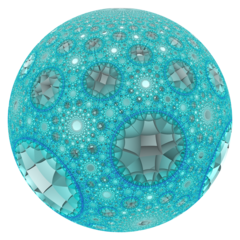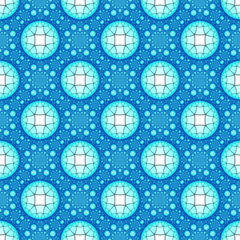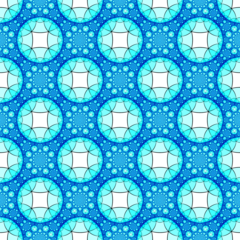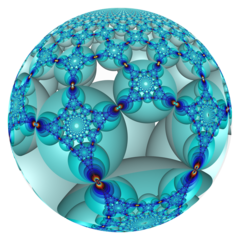Order-4-5 square honeycomb
From Wikipedia, the free encyclopedia
In the geometry of hyperbolic 3-space, the order-4-5 square honeycomb is a regular space-filling tessellation (or honeycomb) with Schläfli symbol {4,4,5}. It has five square tiling {4,4} around each edge. All vertices are ultra-ideal (existing beyond the ideal boundary) with infinitely many square tiling existing around each vertex in an order-5 square tiling vertex arrangement.
| Order-4-5 square honeycomb | |||
|---|---|---|---|
| Type | Regular honeycomb | ||
| Schläfli symbols | {4,4,5} | ||
| Coxeter diagrams | |||
| Cells | {4,4}  |
Faces | {4} |
| Edge figure | {5} | ||
| Vertex figure | {4,5}  | ||
| Dual | {5,4,4} | ||
| Coxeter group | [4,4,5] | ||
| Properties | Regular | ||
Images
 Poincaré disk model |
 Ideal surface |
Related polytopes and honeycombs
Summarize
Perspective
It a part of a sequence of regular polychora and honeycombs with square tiling cells: {4,4,p}
Order-4-6 square honeycomb
| Order-4-6 square honeycomb | |
|---|---|
| Type | Regular honeycomb |
| Schläfli symbols | {4,4,6} {4,(4,3,4)} |
| Coxeter diagrams | |
| Cells | {4,4} |
| Faces | {4} |
| Edge figure | {6} |
| Vertex figure | {4,6} {(4,3,4)} |
| Dual | {6,4,4} |
| Coxeter group | [4,4,6] [4,((4,3,4))] |
| Properties | Regular |
In the geometry of hyperbolic 3-space, the order-4-6 square honeycomb is a regular space-filling tessellation (or honeycomb) with Schläfli symbol {4,4,6}. It has six square tiling, {4,4}, around each edge. All vertices are ultra-ideal (existing beyond the ideal boundary) with infinitely many square tiling existing around each vertex in an order-6 square tiling vertex arrangement.
 Poincaré disk model |
 Ideal surface |
It has a second construction as a uniform honeycomb, Schläfli symbol {4,(4,3,4)}, Coxeter diagram, ![]()
![]()
![]()
![]()
![]() , with alternating types or colors of square tiling cells. In Coxeter notation the half symmetry is [4,4,6,1+] = [4,((4,3,4))].
, with alternating types or colors of square tiling cells. In Coxeter notation the half symmetry is [4,4,6,1+] = [4,((4,3,4))].
Order-4-infinite square honeycomb
| Order-4-infinite square honeycomb | |
|---|---|
| Type | Regular honeycomb |
| Schläfli symbols | {4,4,∞} {4,(4,∞,4)} |
| Coxeter diagrams | |
| Cells | {4,4} |
| Faces | {4} |
| Edge figure | {∞} |
| Vertex figure | {4,∞} {(4,∞,4)} |
| Dual | {∞,4,4} |
| Coxeter group | [∞,4,3] [4,((4,∞,4))] |
| Properties | Regular |
In the geometry of hyperbolic 3-space, the order-4-infinite square honeycomb is a regular space-filling tessellation (or honeycomb) with Schläfli symbol {4,4,∞}. It has infinitely many square tiling, {4,4}, around each edge. All vertices are ultra-ideal (existing beyond the ideal boundary) with infinitely many square tiling existing around each vertex in an infinite-order square tiling vertex arrangement.
 Poincaré disk model |
 Ideal surface |
It has a second construction as a uniform honeycomb, Schläfli symbol {4,(4,∞,4)}, Coxeter diagram, ![]()
![]()
![]()
![]()
![]()
![]()
![]() =
= ![]()
![]()
![]()
![]()
![]()
![]() , with alternating types or colors of square tiling cells. In Coxeter notation the half symmetry is [4,4,∞,1+] = [4,((4,∞,4))].
, with alternating types or colors of square tiling cells. In Coxeter notation the half symmetry is [4,4,∞,1+] = [4,((4,∞,4))].
See also
References
External links
Wikiwand - on
Seamless Wikipedia browsing. On steroids.










